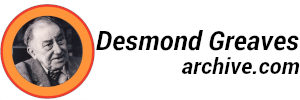C.S. Parnell (1846-1891)
[Review by Desmond Greaves of “Charles Stewart Parnell: The Man and his Family” by Roy Foster, Harvester Press, 1976, £9.95. The review was written in the February 1977 “Irish Democrat” under one of Greaves’s pseudonyms, “Ciaran Desmond”.]
Important new Light on Parnell
In the Parnell mythology, the central figure – a Protestant landlord leading the peasantry against his own class; a cold calculating politician who delivered himself up to his enemies for the love of a woman – is accepted as simply a “lusus naturae” neither capable of nor requiring explanation.
Mr. Foster will have none of this: empiricist as he professes himself, he seeks out the logic underlying the phenomenon, Charles Stewart Parnell.
First he sweeps away some beliefs traceable to party hagiology: that Sir John Parnell, for example, the great-grandfather who lost his chancellorship of the Exchequer for opposing the union of 1801, was a foe to Protestant ascendancy; that Dora Stewart Parnell indoctrinated her son with American anglophobia; or that Parnell’s financial difficulties, which the tribute of 1883 was intended to resolve, stemmed wholly from his political activities.
On the positive side Mr Foster establishes as an important influence the four published works of Grandfather William Parnell, from which the Home Rule leader undoubtedly acquired whatever understanding of Irish history he possessed. A more important inheritance was a liberal view of the land question – which, as this book shows, was to some extent shared by other Wicklow gentry. In a county that had been spared the worst of the Great Famine many proprietors, several of them kin to the Parnells – Howards, Powerscourts, Tighes, Synges, Grattans and Bartons for example – had a relationship with their tenants unembittered by the memory of evictions.
From sparse materials – chiefly Parnell’s mother to A.M. Sullivan, memoirs published by his sister Emily Dickinson in 1905 and brother John Howard in 1916, and references in the writings of Katharine Tynan – the author extracts much hard information about the immediate family. Among the ten siblings who reached maturity he isolates a “political” or assertive group which includes the short-lived poetess Fanny – her “Hold the harvest” is quoted in full and its ambivalent imagery examined – and Anna, the resolute leader of the Ladies’ Land League, who swam out to sea in 1911 and so brought to an end nearly thirty years of bitter disillusionment with Irish nationalism. She had never spoken to her brother after his abandonment of the LLL in 1883.
For several reasons this work merits the epithet definitive. A relentless search through some hundreds of entries in the Dublin Registry of Deeds has yielded a clear record of the Parnell estates from the mid-eighteenth century through the rapid financial decline following the death in 1859 of Charles’s father and down to 1899 when the Avondale property was sold. A new importance is also given to Parnell’s heavy, unprofitable investments in sawmills, quarries and mines.
If Parnell remains an enigma, the book nevertheless discovers a rationale for much of his conduct, and most signally for his momentous entry into politics in 1875.
It has an index, careful notes, and a neat ten-page group bibliography, but the editing is often faulty; the number of misprints would be excessive in a cheaper book and on p.15 there is a meaningless, anachronistic reference to Addison and Steele.
– – –
